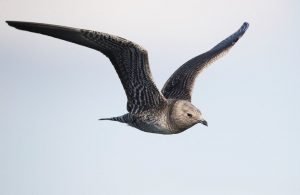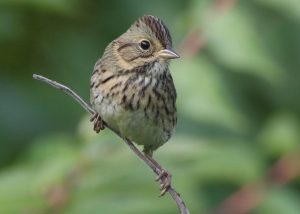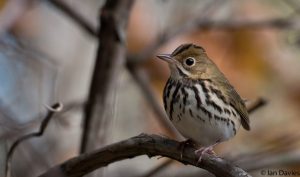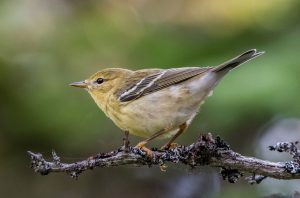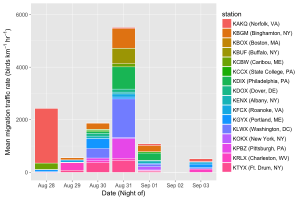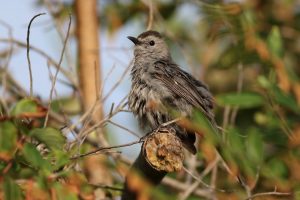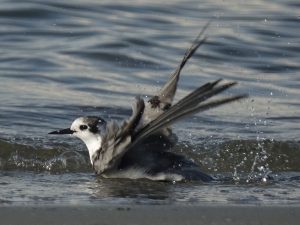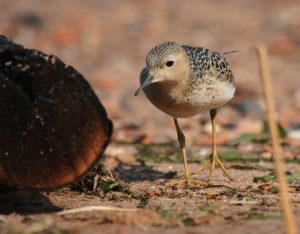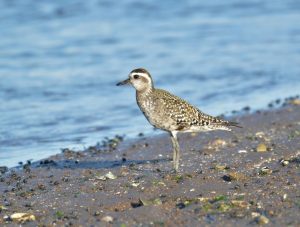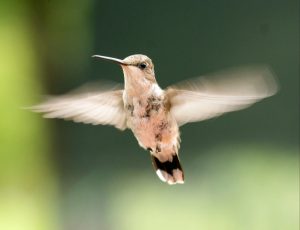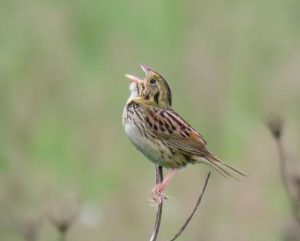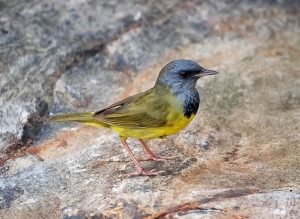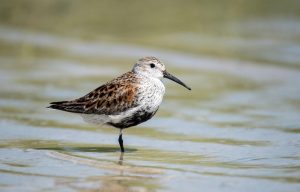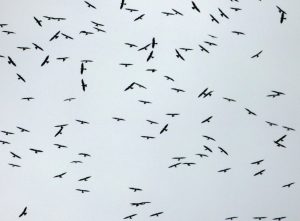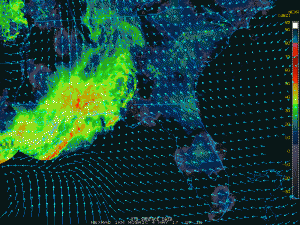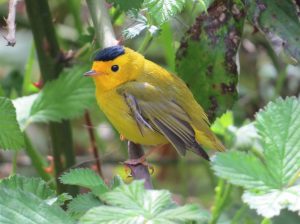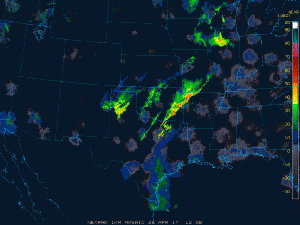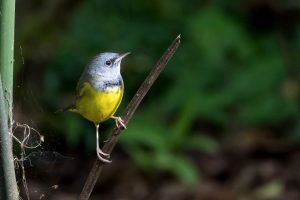News: Forecast and Analysis
Moderate to locally heavy flights occurred in many areas of the West this period and featured Cackling Goose, Greater White-fronted Goose, Ring-necked Duck, Merlin, American Pipit, Fox Sparrow, Golden-crowned Sparrow, and Lincoln's Sparrow, while moderate to locally very heavy flights occurred in the East, featuring Sharp-shinned Hawk, Gray-cheeked Thrush, Ruby-crowned Kinglet, Yellow-rumped Warbler, Palm Warbler, Savannah Sparrow, Harris' Sparrow, White-crowned Sparrow and White-throated Sparrow. Read more...
Pulses of favorable migration conditions this week in the West will bring moderate flights featuring Turkey Vulture, Pectoral Sandpiper, Parasitic Jaeger, Common Tern, Mountain Bluebird, Summer Tanager, and Orange-crowned Warbler, while the East experiences scattered moderate to heavy flights featuring Eastern Wood-Pewee, Yellow-bellied Flycatcher, Red-eyed Vireo, Blue-headed Vireo, Swainson's Thrush, Magnolia Warbler, and Common Yellowthroat when conditions allow. Another tropical system off the Atlantic coast brings potential for interesting observations, as does a tropical system moving across the Gulf of California and into the southern Rockies and western Texas. Read more...
Moderate movements were the norm in many areas of the West this period and featured Say's Phoebe, American Pipit, Ruby-crowned Kinglet, Townsend's Warbler, Fox Sparrow, and Lincoln's Sparrow, while moderate to heavy flights featuring Sharp-shinned Hawk, Merlin, Ruby-crowned Kinglet, Swainson's Thrush, Gray-cheeked Thrush, Magnolia Warbler, Palm Warbler, and Yellow-rumped Warbler dominated the early and late days of the period in the East. Hurricane Irma brought a nasty dose of devastation to portions of the Southeast, while carrying a large array of storm-borne vagrants. Read more...
Light to moderate movements featuring Sora, Pacific-slope Flycatcher, Warbling Vireo, House Wren, Swainson's Thrush, Common Yellowthroat, and early Golden-crownd Sparrows will be widespread from Saturday to Wednesday in the West, while two pulses of favorable migration conditions sandwiched around Irma will bring heavy flights featuring American Golden-Plover, Least Flycatcher, Swainson's Thrush, Yellow-throated Vireo, Blue-gray Gnatcatcher, Ovenbird, and Chestnut-sided Warbler in the East. Irma comes ashore after devastating the Caribbean, bringing with it a large haul of pelagic and nearshore species. Read more...
Light to locally heavy flights, particularly in the first half of the period, occurred in the West and featured Common Loon, Black-bellied Plover, Say's Phoebe, Swainson's Thrush, White-crowned Sparrow, and Lincoln's Sparrow, while numerous moderate to heavy flights featuring Gray-cheeked Thrush, Swainson's Thrush, Blackpoll Warbler, Tennessee Warbler, Orange-crowned Warbler, Wilson's Warbler, and Lincoln's Sparrow were the norm across the East following the passages of a significant frontal boundary. Read more...
Welcome to our first fall 2017 installment of the traffic report describing northeast US nocturnal bird migration traffic rates, as calculated from a completely automated pipeline of algorithms. The images you see in Traffic Reports present the migration traffic rate (MTR), direction of bird movement, and speed of bird movement. See our first report or scientific paper for more information […] Read more...
Pulses of early and mid period favorable migration conditions will bring similarly time pulses of moderate flights to many areas of the West featuring American White Pelican, Killdeer, Elegant Tern, Cassin's Vireo, Yellow Warbler, and MacGillivray's Warbler, while a significant mid period cold front will spawn moderate to very heavy flights in the East featuring Buff-breasted Sandpiper, Common Nighthawk, Least Flycatcher, Olive-sided Flycatcher, Warbling Vireo, numerous warblers, and Bobolink. As the remnants of Harvey plod through the eastern US early in the period, a new and currently strong tropical system (Irma) will be approaching the southeastern US by the end of the period; BirdCast will be watching closely. Read more...
Continental Summary Light to moderate movements were the norm in the West and featured American Wigeon, Northern Pintail, Green-winged Teal, Wilson’s Warbler, Townsend’s Warbler, and Green-tailed Towhee, while moderate to locally heavy flights were common in the East and featured American Golden-Plover, Swainson’s Thrush, Canada Warbler, Nashville Warbler, Bay-breasted Warbler, and Baltimore Oriole. Hurricane Harvey […] Read more...
Moderate movements featuring Northern Shoveler, Killdeer, Belted Kingfisher, Warbling Vireo, MacGillivray's Warbler, Yellow Warbler, and Western Tanager are likely in many areas of the West, while the East will see scattered moderate to heavy pulses that feature Blue-winged Teal, Common Nighthawk, Least Flycatcher, Eastern Wood-Pewee, Yellow Warbler, Chestnut-sided Warbler, and Summer Tanager. The dangerous Hurricane Harvey will bring typical Gulf of Mexico bound seabirds and near shore species to inland locations from Texas and Louisiana to Arkansas over the course of the week. Read more...
Light to moderate flights featuring Western Grebe, Clark's Grebe, Pectoral Sandpiper, Red-headed Woodpecker, Wilson's Warbler, Townsend's Warbler, and Nashville Warbler were the norm in the West, particularly toward the end of the forecast period, while widespread moderate to locally heavy flights featuring Blue-winged Teal, Northern Shoveler, American Golden-Plover, Yellow-bellied Flycatcher, Nashville Warbler, Wilson's Warbler were the norm for the East. The total solar eclipse of 21 August also featured some interesting "migration" behaviors, please see our post to check out the observations! Read more...
Conditions in the West are favorable for light to moderate migration featuring Green-winged Teal, Northern Shoveler, Red-tailed Hawk, Least Sandpiper, Red-necked Phalarope, Yellow Warbler, and MacGillivray's Warbler in the first half of the forecast period, while moderate to heavy flights of Wood Duck, Lesser Yellowlegs, Least Sandpiper, Ruby-throated Hummingbird, Great Crested Flycatcher, Yellow Warbler, and Baltimore Oriole will follow the passage of a frontal system through the East late in the period. Read more...
Late season light to moderate flights will occur in widely scattered locations during the forecast period and feature Common Nighthawk, Olive-sided Flycatcher, Eastern Kingbird, Cedar Waxwing, and Brewer's Sparrow, while the most widespread favorable conditions for moderate to locally heavy flights featuring Yellow-billed Cuckoo, Acadian Flycatcher, Blue Grosbeak, Dickcissel, Grasshopper Sparrow, and Henslow's Sparrow in the East come during the weekend and end of the period. Read more...
Light to moderate flights becomes increasingly likely in the West and will feature White-throated Swift, Willow Flycatcher, Western Wood-Pewee, Eastern Kingbird, Swainson's Thrush, MacGillivray's Warbler, and Western Tanager, as spring migration winds down, while scattered moderate to heavy flights featuring Black Tern, Common Nighthawk, Chimney Swift, Yellow-billed Cuckoo, Acadian Flycatcher, Philadelphia Vireo, Cedar Waxwing, and Mourning Warbler will punctuate the migration scene in the East amidst unsettled conditions. Read more...
BirdCast regional analyses return after our global big day absence! Widespread light and moderate to locally heavy flights characterized the first days of this long forecast period in the West and featured Willow Flycatcher, Dusky Flycatcher, Western Wood-Pewee, Swainson's Thrush, MacGillivray's Warbler, Yellow Warbler, and Black-headed Grosbeak, while moderate to very heavy flights occurred in the latter two thirds of the two-week period in the East, first in the Plains and then farther to the coasts, featuring Alder Flycatcher, Yellow-bellied Flycatcher, Philadelphia Vireo, Bay-breasted Warbler, Magnolia Warbler, Canada Warbler, and Wilson's Warbler. Read more...
Favorable migration conditions early in the period bring light moderate flights to many areas of the West away from the Pacific Coast that will feature Dusky Flycatcher, Cedar Waxwing, Yellow-breasted Chat, Bullock's Oriole, Chipping Sparrow, while the East will see locally moderate to very heavy flights featuring Short-billed Dowitcher, Black Tern, Red-headed Woodpecker, Olive-sided Flycatcher, Eastern Kingbird, Swainson's Thrush, Canada Warbler, Common Yellowthroat, and Orchard Oriole in mostly marginal migration conditions that in many areas will hinder or inhibit migration. The second half of the period will see the best chance for more trans-Gulf migration as well as another opportunity for fallouts and concentrations with a passing frontal boundary. Read more...
Moderate flights occurred in many areas of the West and featured Spotted Sandpiper, Wilson's Phalarope, Warbling Vireo, Swainson's Thrush, Western Tanager, Black-headed Grosbeak, and Evening Grosbeak, while in the East moderate and heavy flights punctuated by intense low pressure systems featured Mississippi Kite, Yellow-bellied Flycatcher, Bell's Vireo, Bay-breasted Warbler, Magnolia Warbler, Canada Warbler, Rose-breasted Grosbeak, Bobolink, and Dickcissel. Read more...
Team BirdCast is looking closely at the current frontal boundary pushing across the southeastern US and pondering what it might mean for those competing in the World Series of Birding 2017, among other birding events presumably scheduled in the coming days. Read more...
Conditions are mostly marginal for scattered light to moderate flights of Long-billed Dowitcher, Wilson's Phalarope, Western Wood-Pewee, Swainson's Thrush, Yellow Warbler, Western Tanager, and Bullock's Oriole after a strong frontal passage in the West, while the first half of the period in the East see many areas with favorable conditions for moderate to very heavy flights featuring Short-billed Dowitcher, Black Tern, Common Nighthawk, Willow Flycatcher, Least Flycatcher, American Redstart, and Wilson's Warbler. Conditions for trans-Gulf migration will be generally favorable during the period, with the potential for late weekend and early work week fallouts and concentrations in the Gulf Coast states as frontal passages with precipitation are forecast. Read more...
Team BirdCast has been watching the trans- and circum-Gulf movements unfold in the last days. Today's movement is an exciting one, featuring the arrival of large numbers of migrants and another frontal boundary. Read more...
The West will see light to moderate flights, particularly in the Desert Southwest late in the weekend and late in the work week, featuring Spotted Sandpiper, Long-billed Dowitcher, Swainson's Thrush, Townsend's Warbler, MacGillivray's Warbler, Black-headed Grosbeak, and Western Tanager, while a pulse of highly favorable migration period late in the period in the East will bring moderate to very heavy flights featuring Red-headed Woodpecker, Acadian Flycatcher, Least Flycatcher, Swainson's Thrush, Chestnut-sided Warbler, Bay-breasted Warbler, Northern Parula, and Mourning Warbler. Early period brings a dynamic and complex atmosphere will potential for Gulf Coast concentrations, where late period brings a major incursion of Neotropical migrants across and around the Gulf of Mexico, as favorable flight conditions arrive in Mexico and northern Central America at the peak of the season. Read more...


